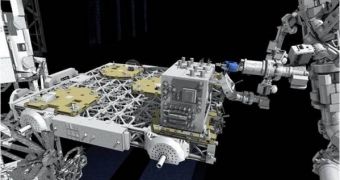In addition to the supplies it delivers to the International Space Station (ISS), the space shuttle Atlantis is also carrying an experiment that could revolutionize the way spacecraft behave and interact in orbit.
The instrument is known as the Robotic Refueling Mission (RRM) and is shaped like a satellite. The mission for which it was designed is to help refuel other satellites in space, while at the same time using its robotic arms to carry out small maintenance work.
Atlantis delivered the equipment when it docked to the space lab on Sunday, July 10, and the astronauts of the joint STS-135/Expedition 28 crew are very curious about how it will perform. If successful, the new technology has the potential to change the space industry.
At this point, numerous spacecraft are withdrawn from active duty because their fuel runs out, which means that they can no longer be maneuvered in space. As such, they begin to pose a danger for the other spacecraft, and need to be taken out of commission.
But having access to a orbital refueling station could take care of that problem. The next generation of refuel/repair satellites could change orbits and move between spacecraft, refueling and repairing them as the need arises, Space reports.
This could contribute to extending the life of space assets considerably, diminishing the number of rocket launches and contributing to stopping the massive growth of space debris and junk. At this point, low-Earth orbit (LEO) is clogged with pieces of rockets, satellites, chips of paint and other parts.
All of them pose a significant challenge for space exploration, and every new spacecraft has an increasing chance of getting hit. The ISS itself has to maneuver out of its orbit about three times per month, when it's threatened by space junk
Today, July 12, NASA flight engineers from the Expedition 28 crew will conduct a maintenance spacewalk outside the space station, during which they will also install the RRM on the exterior hull of the lab.
The experiment's abilities will be put to the test using the ISS Dextre robotic arm. “We anticipate it enabling future missions, future capabilities, for the international aerospace community,” explained Benjamin Reed.
The expert holds an appointment as the RRM deputy project manager at the NASA Satellite Servicing Capabilities Office. He made the statement in a press briefing at the Kennedy Space Center last week.

 14 DAY TRIAL //
14 DAY TRIAL //